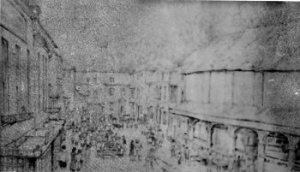Winchester The Square and Great Minster Street
Description Part 1

This was the original location of a palace for Charles II designed by Sir Christopher Wren to occupy the site of Winchester Castle demolished after the Civil War on the orders of Oliver Cromwell.
The avenue of lime trees, seen as a diagonal line across the Cathedral Green, was planted in the second half of the eighteenth century. This photograph shows these trees being felled in 1985, as they were considered to be a danger to the public. The new avenue consists of 28 limes. All this space in mediaeval times was a graveyard much in use during the plague of 1349 when three quarters of the population of Winchester died.
The drawing of the Square in 1825 is a reminder that this area was part of the old Roman Forum, later included within the Conqueror's palace after 1066. The market hall, the site of the present museum, had a frontage of stone pillars and arches with massive oak supports inside. In 1760 the ten years' lease for the butchers' market was forty shillings a year plus one shilling chicken money (the Mayor's delicacy). Two years later the surrounding area was paved and a pump fixed to cleanse the shambles twice a week.

The meat market hall had cattle stalls and slaughtering facilities on the ground floor whilst a large room for hire on the first floor was used by touring theatre companies. A wide variety of entertainment was provided, so much so that it was considered Winchester College boys might be corrupted. Gallery tickets cost one shilling and pit tickets two shillings, whilst the local nobility paid two guineas for a box for the season. This theatre closed in 1784 and a new one in Jewry Street built at a cost of £1,000 opened in 1785.

The Mechanics Institute was established in 1835 after the theatre had closed, through it was still above the butchers' market until 1855. The Corporation granted a lease for the whole building and the ground floor was then used as a reading room. By 1898 the end of the lease was near, still at the original figure of £8 per year, the lessees being the Winchester Technical Institute which had spent £700-£800 to improve the property.
The above photograph is of the present museum built in 1902 on the site of the Mechanics Institute and Reading Room, a Tudoresque design fashionable in the late nineteenth century but not in keeping with other buildings in the street. The immediate space in front had, in earlier days, a town `cayge' and a pillory where 'the Beadle could wield his scourge'. The kerb was re-aligned in 1976 and the present inelegant plant-holders and the popular wooden seat were added in 1980.

The buildings in the background show the site of the parsonage of St Lawrence, now the Eclipse Inn. It probably ceased being used by the Church early in the 1850s and there were beer retailers here from at least 1875. In 1925, a year after the name Eclipse Inn was used (in competition with the Sun Inn at No. 10), the cement covering was removed to expose much of the sixteenth century timber framing seen today both internally and externally. The electric reproduction gas lamps were adopted when the street lighting was re-organised in 1980.

The 15th century framed interior of the bookshop at No. 19 is shown here, used by the Gilbert family since 1904. It was threatened with demolition in 1972 but careful and expensive restoration has renewed both inside and outside.
The photograph of the Square looks north into the cul-de-sac, resurfaced with concrete block paving in 1980. The term 'dumb street' is sometimes used and a part of the Cathedral Close is referred to as Dumb or Dome Alley.
The tower of the church of St Lawrence in the Square can be seen above the shops. It was built on the site of the Savoy Chapel of the Palace of William the Conqueror which was demolished circa 1150. The church was rebuilt in 1449-50 during the time when Henry VI held Parliament in the Great Hall of Winchester Castle, and in Cromwell's time was used as a school. All the tower bells, except one dated 1621, have been removed. The interior is unusual with a double king post roof truss dated 1674. The church was re-dedicated in June 1980 after considerable fire damage in 1978.
